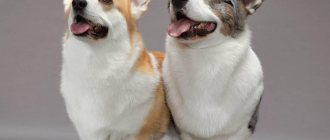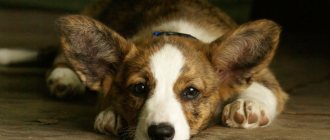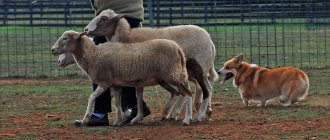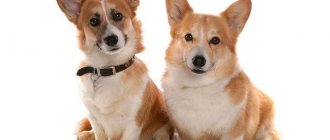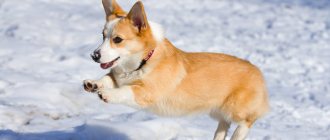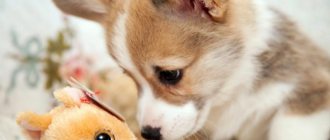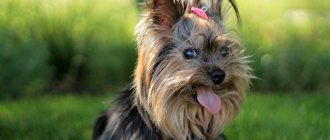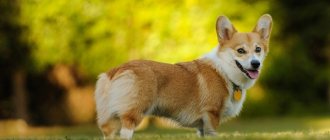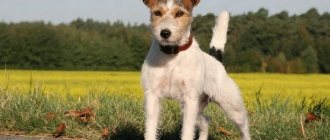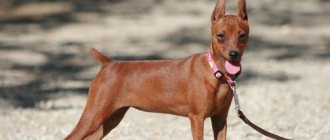01/09/2019 Irina Malinina 0 comments
Most people who are far from dog breeding are unfamiliar with such a breed of dog as the Welsh Corgi. Although these animals have really very ancient roots.
Perhaps you've met a corgi dog on your way. But, without examining it more carefully, you mistook the animal for an ordinary mongrel dog. The small size and the fox-like face of the dog contributed to this.
Currently, the Corgi breed is gaining increasing popularity in the world. This is due to the fact that the animal is very smart and has a great sense of humor. This is confirmed by a large number of photographs depicting a smiling corgi.
The peculiarity of this dog is its resemblance to a fox.
History of appearance
The Welsh Corgi is an ancient herding dog. This is the smallest shepherd dog available in the world. People first started talking about her in the 11th century, noticing her unique abilities as a shepherd. The dog could grab cows by the legs without fear of retaliation. Having short legs and small stature, she successfully dodged the animal's retaliatory strike.
Corgis could quickly change their herding tactics if circumstances changed. They have always been disciplined and driven.
There is a beautiful legend that presents corgis as sled dogs for elves. This is confirmed by the coloring in the shape of a saddle on the dog’s back. A little later, the elves gave corgis to the peasants.
History does not provide accurate information about the origin of this breed. But it is known that a thousand years ago the short-legged ancestors of these animals already lived in Wales. It is unknown why dogs have short legs. Either this is the result of a natural mutation, or the reason lies in the crossing of dogs from Wales with Vallhunds.
The breed was a great success in Great Britain and neighboring countries. And it is completely unclear why she did not receive official recognition for a long time. Only since 1892 has the corgi been seen at exhibitions. After this, she immediately attracted the interest of breeders.
The love shown by the royals for the corgi dog made the animal popular.
Their popularity increased even more after King George gave these funny dogs to his daughters. Entire dynasties of aristocrats began to keep this breed of dogs.
Small corgi dogs constantly accompany Queen Elizabeth II during her trips, walks and even official ceremonies.
Elizabeth breeds dogs herself. The Queen considers them part of the family and even gives them gifts for Christmas. But it is unlikely that you will be able to get a dog of royal blood; only friends and people close to the queen receive the animal as a gift.
The Welsh Corgi dog breed is usually divided into two types: Cardigan and Pembroke. They have some differences.
Cardigan
If you believe the statements of historians, the Cardigan breed appeared much earlier than the Pembroke breed. Ceredigion is considered to be the birthplace of cardigans. The ancestors of the Cardigan Welsh Corgi were brought to Britain by the Celts.
Ceredigion and Pembrokeshire are neighboring counties in Wales. But there are high mountains between them, so Cardigans and Pembrokes simply did not have the opportunity to interbreed.
Cardigans are similar to dachshunds, while Pembrokes are more similar to spitz dogs.
Externally, Cardigans differ from Pembrokes. The back of their body is narrower. The front of the animal is more massive, because of this the paws are slightly turned outward.
If you look at the dog from the front, you will see that the Pembroke's paws are shaped like the letter P, while the Cardigan's paws look like an X.
The cardigan has coarser and shorter hair, the color of the animal can be different. The dog has a close and watchful gaze, its eyes are almond-shaped.
Cardigans have an independent character. They almost never impose themselves and endure loneliness much easier. But they also need human attention! They need physical activity because the habit of work is in their genes. But they will also be happy to take long walks on foot with a change of routes.
Welsh Cardigans are wary and distrustful of strangers.
And if the Pembroke looks like a cute fox, then the Cardigan shows itself as a serious and focused dog.
Pembroke
The Pembroke Corgi dog breed gets its name from a combination of words. Welsh is translated as Wales, Pembroke - means the county of Pembrokeshire, which is considered to be the birthplace of the animal. The word “corgi” does not have a single interpretation, and means either a dog or a dwarf.
Pembrokes are considered younger than Cardigans. It may well be that their ancestors came to Wales thanks to craftsmen and weavers from the Flemish county.
The Pembroke Welsh Corgi is more emotional. Just walking is not enough for them. The animal will be bored and hover around, attracting the owner’s attention. It loves games and will enjoy playing sports.
They are not as wary of strangers as cardigans. They treat them more calmly. But, unlike a cardigan, which carefully thinks through and weighs everything, they are characterized by a lightning-fast reaction. Pembroke will do first and think later.
Training at 4 - 5 months
By this time, the Welsh Corgi Cardigan puppy has already become accustomed to your home and usual walking areas, and no longer needs your support and care so much. He begins to flirt with other dogs, pretend that he does not hear you when you call him, and show a certain persistence and disobedience when performing various commands.
This means it's time to move on to full training . In classes at this age you can already be persistent and demanding. At the same time, the most important thing is not to overdo it, remember that classes should bring joy to both you and your dog, and only then you can achieve the desired result.
Required commands in 4 months
What commands are practiced by a Welsh Corgi Cardigan puppy at 4 months:
- Calm movement next
to the owner with and without a leash, with landing when stopping, with a change in pace and direction of movement - Return to you
upon request - Staying
in a free or certain position (sitting, lying, standing) for a long time: if necessary, wait for the owner on the street, when visiting a store or other establishment - Indifferent attitude towards treats scattered on the ground
- Inhibitory command
to stop unwanted actions - Execution of a set of commands “sit”, “lie down”, “stand”
at a distance and near the leg, when giving commands by voice and gestures - Stop barking
on demand.
Dog appearance (standards)
With small external parameters, the Welsh Corgi does not at all resemble a decorative dog. This animal is strong, well built, capable of doing hard work.
Dimensions
The weight of the animal ranges from 9 to 14 kg. The height is small and is 25-30 cm.
Wool
The standard requires the breed to have short hair. The coat must be coarse and fit well to the animal's body. The undercoat is also short and does not get wet. Pembrokes have a slightly softer coat than Cardigans.
Colors
The coat of this breed of animals has the following colors: red, red-white, red-white-black, fawn, black and tan sable. There are white markings on the fur.
Pure black color is quite rare!
Head
The Welsh Corgi has a wide skull and a not too long muzzle. The ears are small, but always erect.
The animal's mouth seems to be outlined with black paint. It is because of this that the animal seems to be constantly smiling.
Body and limbs
The body of the animal is strong. The corgi's paws are set straight. The limbs of the Cardigan are longer than those of the Upembroke.
Tail
A straight and low tail is considered ideal.
But Pembrokes have a gene that causes bobtail. Puppies may be born virtually tailless or have a standard long tail. Now people who want to buy a Pembroke Welsh Corgi have a choice: they can buy an animal with a bobtail or with a normal tail, similar to a fox.
Rock defects
Even the slightest deviation from the standard is considered a defect. It happens that puppies are born with long, beautiful hair, or it is simply softer and more pleasant to the touch. This deviation is also considered a defect. After all, thin hair does not protect the animal from moisture at all and constantly collects all sorts of debris.
Appearance of a Welsh Corgi Cardigan
General impression
Miniature “shepherd dogs” reach a height of 32 cm at the withers, and by adulthood they gain weight up to 12 kg.
As you can see in the photo, the Cardigan Welsh Corgi has a well-defined mouth, which is why the animals seem to be “smiling.” Previously, dogs had to have their tails docked, but after the ban on cosmetic surgeries was introduced, individuals with tails of different lengths are found.
Head
The dogs have a “fox” head - a flat and wide skull between the ears, gradually narrowing towards the eyes and hanging slightly over them. The size of the Cardigan Welsh Corgi's muzzle in proportion to the skull is 3:5. Nose – wet, black.
Neck
Strong, muscular, proportional to the body. The back is straight, the chest is powerful and wide.
Torso
The body with developed muscles is longer than that of the Pembroke. The front legs are wide, short, elbows touching the sides. The hind legs are short, with developed hips.
Tail
“Foxy” and long. When moving, it rises higher than its back; when at rest, it drops almost to the ground.
Movement
In their young years, dogs have strong and elastic muscles, they are very playful and active. Over the years, the animal moves less, the muscles become flabby, the animals change running to walking, sleep more and often become obese.
Wool
When young it is soft and shiny. Over the years it becomes tougher, turns pale and breaks. In older dogs, the coat is uneven in structure, often looks patchy and quickly becomes dirty. It needs careful care.
Welsh Corgi Cardigan colors
Breed standards allow brindle, red, harlequin, sable, 3-color with different markings. The nose and eyes are outlined in black. White spots can be located on the neck, paws, chest, muzzle, tip of the tail and lower body.
Dimensions
The growth of the Cardigan Welsh Corgi is constantly increasing - in newborns it is up to 8 cm; at the age of 1-2 months – 7-10 cm; 3 months – 13 cm; 4 months – 15 cm; 5 months – 22 cm; 6 months – 27 cm; 7-10 months – 32 cm.
The weight of a Cardigan Welsh Corgi at 2 months is 2.5-4.1 kg, and in adulthood the dogs weigh up to 13 kilograms.
Welsh Corgi character
The Pembroke Welsh Corgi is a cheerful and positive dog. It seems that they live every day with a smile. The Welsh Cardigan is a more serious dog.
These are smart animals. The development of their intellectual abilities began a very long time ago. Working on pastures with large numbers of livestock required them to maneuver and act smartly in order to complete the task and save their lives.
Welsh Corgis are very curious. You can be sure that they will study every shelf in the cabinet and every bush in the area. With these studies, they train their memory, which will be useful in training in the future.
If an animal lives in an apartment, this does not give the right to consider it a sofa dog. Corgi dogs are very brave creatures. From birth, they have their own dignity and require respectful treatment. But don't try to make this dog a guard! You may never expect aggression from a corgi, because corgis are shepherds by nature.
An animal will never be the first to start a conflict. But he can stand up for himself!
The little Welsh Corgi is a very friendly creature. It seems that this dog has set itself the goal of making a lot of friends. Moreover, not only a person, but also a dog and even a cat can become her friend.
Corgi's optimism is overflowing. Their positivity and lack of despondency helps them become good friends for children of different ages. They are very patient, and you can be sure that Welsh Corgi children will not be harmed in any way. Moreover, they will always stand up for them.
Despite the fact that the corgi loves the whole family, it considers only one person to be its owner. He treats strangers either curiously or indifferently.
Corgis love people and communication. You need to pay attention to your pet every day so that he does not consider himself lonely and abandoned.
Always remember that it is impossible to fit the character and behavior of an animal into a certain framework. Each animal is unique!
History of the origin of the breed
The appearance of this breed is shrouded in many secrets and myths; there is still no consensus about their origin. According to one version, the ancestors of modern Welsh Corgi Cardigans lived in the British Isles with the Scandinavians back in the Bronze Age. Other scientists claim that corgis lived with the Celts before our era.
Welsh Corgi Cardigan
Interesting! There is a legend according to which elves rode these small dogs. The evidence is still supposedly preserved - on the backs of the cardigans there are small marks, as if from a saddle.
Corgis are natural shepherds who always lived side by side with humans and helped herd cattle. They did their job by biting sheep and cows on the legs, thereby directing the herd in the right direction.
Welsh Corgis are divided into two breeds:
- cardigan (originally from Cardiganshire);
- Pembroke (from Pembrokeshire).
But it was not always so. For a long time they were the same breed, but disputes and even fights between breeders for leading positions pushed them to separate in 1934. The Welsh Corgi Cardigan breed remained in the shadow of the Pembroke, due to the more pretty appearance of the latter. To emphasize the difference between the breeds, Pembrokes began to have their tails docked.
In our country, people started talking about corgis only at the beginning of the 2000s.
Care and maintenance
Care for this animal is standard. Initially, prepare a separate place for the dog. This could be a lounger or a firm pillow. It is advisable to place it in a place from which there is a good view. It is very important for a corgi to see the whole family.
Particular attention will have to be paid to wool. It is recommended to scratch it several times a week. Twice a year the dog has a pronounced seasonal shedding. During this time, you will have to scratch it very often.
This animal is rarely bathed, since the water-repellent coat practically does not accumulate dirt.
If the dog gets very dirty during a walk, it can be wiped with a damp towel.
You need to look after your ears very carefully. Protruding ears often collect a lot of dust and dirt. To avoid various diseases, it is recommended to wipe them with a swab dipped in a special lotion.
The dog's paws also need to be given attention. In addition to removing dirt, nails also need to be trimmed as necessary.
Get your corgi used to wearing a collar right away.
It is not recommended to use a harness for walking! It can lead to uneven load distribution and cause back problems.
Thanks to a good undercoat, the dog will not have to be dressed in warm clothes when cold weather sets in.
It should be borne in mind that adult shepherd dogs have a good appetite. To avoid problems with excess weight, animals need to be fed at certain times. Fatty foods should be excluded from the diet. Sometimes you can diversify your pet's menu with broth, vegetables and fruits.
Be sure to worm your pet and vaccinate it annually!
Education and training
Welsh Corgis are very smart dogs. They are quite easy to train, since they grasp any command almost on the fly. Thanks to their intelligence, they quickly assess the situation.
An animal will not obey a hysterical, inconsistent or cruel person.
The main difficulty is that the pet constantly strives to learn new things, and monotonous, monotonous commands quickly tire them. The owner will have to use all his imagination in the work to diversify the training and make it interesting.
Corgi puppies often try to herd all living creatures that move nearby into groups. They even try to bite people on the heels, thus directing them where they see fit.
This problem can be avoided by starting to raise your pet from an early age.
Under no circumstances should you shout at a corgi!
The animal does not understand how to react to an increase in tone, and your ferocious cry may simply be ignored. These dogs are intelligent and will be able to understand any command spoken in a calm tone.
Dogs love human laughter very much.
The animal will not harbor grudges against its owner. It will do everything possible to make a person laugh. No wonder these dogs performed in traveling circuses.
It is impossible not to pay attention to the uniqueness of this dog in training. Animals can even be taught to dance, known as canine freestyle. This is a very spectacular sport that consists of various movements performed to the tempo of music. Watching the dancing Welsh Corgis, you are unlikely to contain your smile, they are so cute and funny. Almost always they are among the leaders in this sport.
Training and education: what is important to know
You need to start raising a pet as early as possible, from the moment it arrives in the house. If this is not done, the Corgi will become spoiled and uncontrollable. The Cardigan dog breed is distinguished by high intelligence. They are easy to train and immediately understand what is wanted from them. Even a novice dog breeder can train them.
Basset Hound: description of dog breed and character
From childhood, puppies are taught to respond to a name, use a tray or diaper, and with age, you need to teach your pet to tolerate and relieve natural needs during a walk. Children are also taught to use a collar and leash, and boundaries of what is permitted are set. You also need to teach the Cardigan in what cases it is possible to bark and when not.
Helpful information! It is better to approach training in a playful way, so the pet will better learn the commands. Corgis get tired of tedious, monotonous activities and stop listening to their owner.
When Welsh Corgis reach adolescence (usually 6-7 months), they may stop listening to their owner and become a little naughty. You need to be patient and not show aggression towards the dog, because this period will quickly end.
Cardigans can't sit idle, so they need to be occupied with something. Agility (obstacle course) or freestyle are perfect for them.
Cardigan training
Dog health
If the pet has a good pedigree, then with proper care it will be healthy until old age. After all, this is a strong and hardworking breed.
A nuance is the problem with independent mating and childbirth; corgis often cannot cope with this on their own. You have to seek the help of an experienced breeder.
Like any other breed, Corgis are prone to a number of diseases. Among them, the most common are cervical disc diseases and eye diseases. Animals have skin asthenia, epilepsy, urinary tract diseases and other diseases.
You should only buy a puppy of this breed from nurseries. Competent breeders approach breeding issues responsibly and do not use sick animals for this purpose.
How to choose a puppy
If you are ready to buy an animal, do not rush to grab the first puppy you come across at the bird market. Go through the nurseries and choose the best one based on your own observations and reading reviews from other customers.
Before purchasing, it is advisable to study the pedigree of both parents of the puppy and make sure that the future pet has a passport or puppy card.
Observe the puppy's behavior. A healthy baby will always be active and curious; aggression in his behavior is unacceptable. The puppy's appearance should be ideal: the coat is shiny and clean, the eyes and ears are free of any signs of discharge.
Consider the living conditions of the mother and her babies, pay attention to what and how they are fed.
Be sure to ask the breeder questions: specify the type of feeding, the time of vaccination.
How to raise a Welsh Corgi puppy
If you train your pet correctly, then over time you will get an obedient dog that will follow all commands and delight you every day. Experts believe that several factors may influence the Welsh Corgi’s receptivity to various commands:
- pet's temperament - the speed of the pet's reaction to stimuli, both positive and negative;
- character - how exactly the dog resists various unpleasant influences;
- obedience - the dog’s ability to accept human leadership;
- vigilance - the speed with which the dog notices potential danger, both in relation to itself and in relation to the owner;
- aggressiveness - the pet’s ability to react hostilely to potential danger;
- curiosity - interest that is developed when a dog feels, hears and sees something;
- sociability - the ability to interact with people;
- possessiveness is the interest shown by animals in certain objects, for example toys.
How quickly your dog will learn commands depends on which traits predominate in the character of a Welsh Corgi puppy. By paying attention to the character traits of your animal, you can find an approach to it and adjust its behavior in certain situations.
- Eagerness will get you nowhere . You should not try to teach your Welsh Corgi puppy all the commands at the same time; you need to learn the commands one by one. You need to have patience and act methodically. You should not scold your pet at the moment when he makes mistakes, and when he succeeds in something, then the pet should be encouraged.
- Don't hit . It is prohibited to use physical punishment against a pet until it is three months old. You should limit yourself to variable intonation, but avoid shouting. Once your Welsh Corgi puppy is three months old, it is acceptable to use a light spank while saying “Ew” as punishment. It is necessary to punish immediately when the animal commits an offense, and not after it, since the animal simply will not understand what exactly it was punished for.
- Subsequence . The main goal is to ensure that the pet follows the command the first time. Commands should be pronounced clearly and in an even voice so that the dog understands and obeys you. All family members should be involved in raising the dog, but they must act together. It is forbidden to allow situations in which you scold the puppy, and another family member praises him or simply does not pay attention.
- Pamper . Remember to reward your Welsh Corgi puppy with a variety of treats and praise when he has done what is asked of him.
How much does a puppy cost?
Corgi dogs are considered quite exotic in Russia and are not cheap.
The lowest price - 15-25 thousand - will be given to a puppy who, for some reason, is not destined to participate in exhibitions. Among these reasons are the following: too long coat, color that does not meet the standard, and the absence of several teeth. A puppy fit for exhibitions will cost 30-40 thousand rubles. And the highest price will have to be paid for an animal that will definitely bring victories, prizes and titles to its owner. The cost of such an animal will be on average 55 thousand rubles.
There is no need to look for a cheaper puppy. Low cost often hides health problems.
How much does a Cardigan Welsh Corgi cost?
It is better to purchase a Cardigan Welsh Corgi from a reliable kennel or from a reputable breeder. Non-purebred animals are usually sold through private advertisements and on the market. Due to the difficulty of breeding, dogs cannot be cheap! Kids are divided into classes:
“Pet” - due to disqualifying defects they do not take part in exhibitions and breeding, they are usually kept as pets, they cost about 20 thousand rubles.
“Bridd” are dogs with a good pedigree, but also with minor shortcomings that do not allow them to take prizes at exhibitions. Used when crossing with other herding breeds. The price of a Welsh Corgi Cardigan of this class starts from 35 thousand rubles.
“Show” – individuals with excellent external characteristics, participating in exhibitions and taking first places. Their cost ranges from 65 to 100 thousand rubles.
Famous nurseries engaged in breeding the breed: “Crimson Autumn” in Moscow, “Azel-Hof” in Tambov, “Fan-Corgi” in Kaluga, “Arabelde-Grand” in Ufa.
Pros and cons of the breed
The advantages of the breed include the following nuances:
- smart animals;
- wonderful companions;
- feel good in apartments;
- easy to train;
- have a calm character;
- positive and cheerful;
- suitable for beginners;
- not selfish;
- not aggressive.
The breed also has disadvantages:
- tendency to obesity;
- unreliability as a security guard;
- the need for education from the first days;
- tendency to diseases and problems during childbirth.
